Troop 260 Finds 100 Miles of Adventure on Salmon River

After paddling for miles and navigating through rapids and around boulders, it feels nice to hop out of your inflatable raft for a bit and admire the scenery. For Troop 260 of San Jose, California, the Scouts could do that while relaxing in geothermal pools alongside the river.
“There were a bunch of hot springs throughout the trip,” says Life Scout Matthew Lewis, 16. “There were different pools that were different temperatures. Some were hot, and some were cold. They were definitely a highlight of the trip.”
That trip last July took the group 100 miles down Idaho’s Salmon River, past towering, jagged cliffs and cascading waterfalls. It took three years of planning, but the result was an adventure the Scouts had never experienced before.
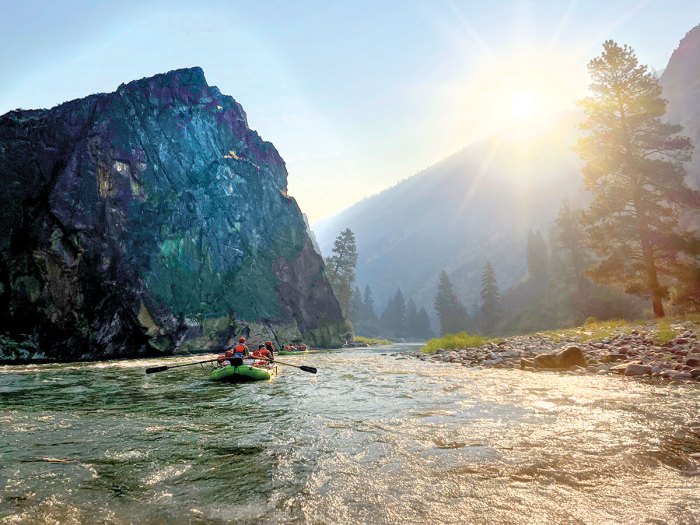
SOMETHING DIFFERENT
For years, Troop 260 alternated its high-adventure plans: One year it’s backpacking, the next canoeing, then back to backpacking and then canoeing again. They wanted to try a new activity.
“We’d never been whitewater rafting,” says Aidan Lavery, 17, a Life Scout. “We voted and Salmon won. When you’re looking up the pictures, we saw the canyons — it was pretty amazing.”
The Salmon River cuts across central Idaho, running 425 miles through national forests and mountain ranges. It took 14 hours on the road traveling from California to Bradley Scout Reservation, where the group spent the first night and met their guides.
“They showed us all the equipment we’d use,” says First Class Scout Pierce Rock, 15. “They showed us dry bags as well as the life jacket and helmets.”
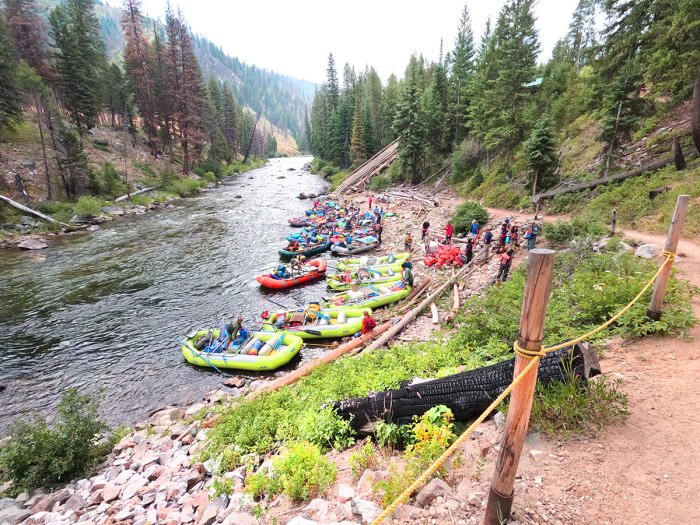
The troop prepares to launch at the Middle Fork of the Salmon River.
RAFTING 101
The Scouts planned for 20 miles a day on the Salmon River. Some of them would ride in one of the large inflatable rafts that would also carry their gear. Others would paddle one-person inflatable kayaks.
“We called the kayaks ‘duckies,’ and the rafts were the ‘momma ducks,’” says Life Scout Maanasa Ramprasad, 17.
The Scouts would trade off because a kayak gave a different experience than a raft. In a raft, you could relax more, while a kayak put you closer to the water.
“Even the smaller rapids, you felt them more,” Pierce says. “It felt more like you’re in nature.”
When the group approached rapids, the protocol was always the same.

Top: Conor Lavery, Pierce Rock and Maanasa Ramprasad, along with their guide, eagerly look down river. Middle: Ben DeHart and Joshua Archila are all smiles after paddling through rapids.
“We’d park the rafts before the rapids,” Maanasa says. “The guides would make sure it was safe to pass. I think all the Scouts enjoyed the rapids, especially the higher-class ones.”
Whitewater rapids are rated from the calm Class I to the potentially deadly Class VI. In Scouting, older Scouts who are classified swimmers can take on rapids up to Class IV with a professionally trained guide.
The whitewater varied between Class II and Class IV on the troop’s route. Some days took the Scouts over more rapids than others. But every day, they found something fun to see or do.
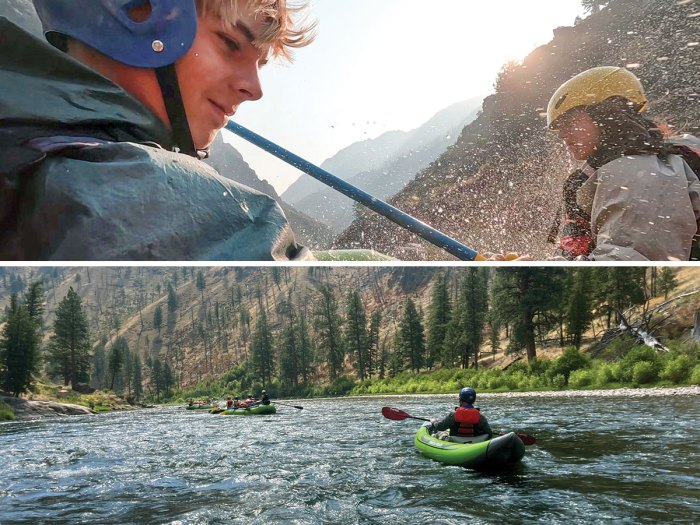
Top: Ben DeHart and Joshua Archila navigate through rapids.
CREW CAMARADERIE
Idaho is home to hundreds of hot springs. Most of them are heated by energy from underground fault lines. In addition to soaking in these pools near the river’s shores, the Scouts checked out caves adorned with ancient paintings, and they spotted wildlife, including bighorn sheep and river otters.
They also went on day hikes and bathed under waterfalls.
“There was this waterfall that changed direction based on how the wind was blowing,” Maanasa says.
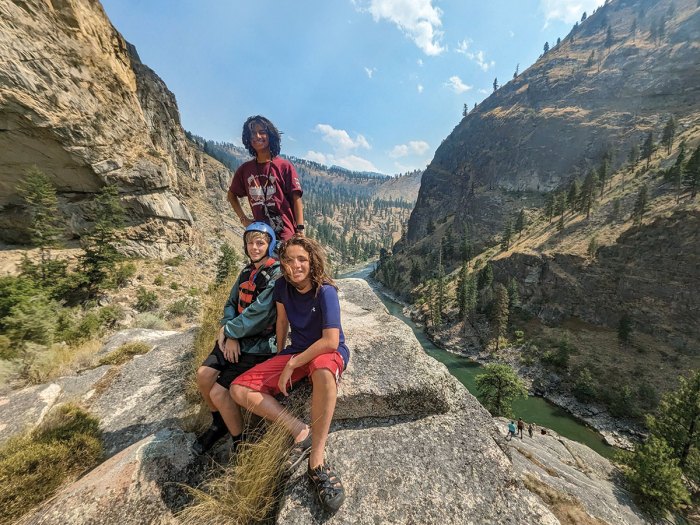
Joshua Archila, Ben DeHart and Jayden Patel pose as they enjoy the view.
On the water, the Scouts entertained themselves by telling riddles or hopping out of the rafts to swim where it was safe.
“A huge part is spending time with your troop and your guides,” Pierce says.
High-adventure trips are more than trying a new activity. They’re also times to build friendships and have fun. At the end of each day, the guides led the group in playing games and singing songs. They also prepared gourmet meals and served a Dutch oven cake after each dinner.
“It wasn’t like our normal food,” Matthew says. “We’re accustomed to hot dogs and cookies.”
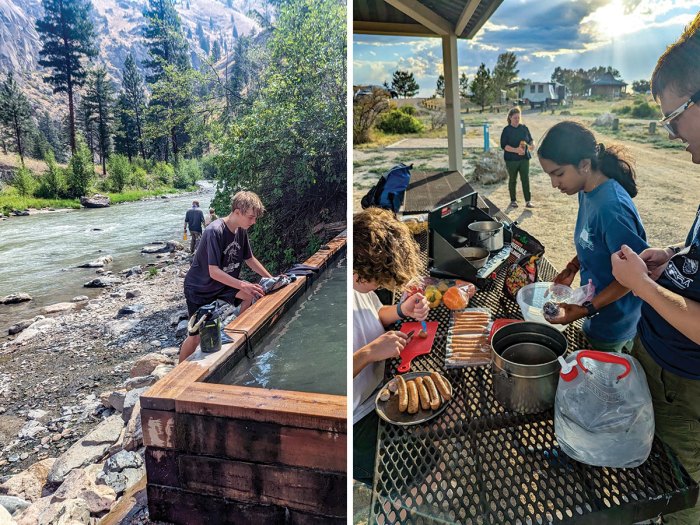
Left: Aidan Lavery checks out a tub that was built to capture a hot spring. Right: Aidan Lavery, Maanasa Ramprasad and Pierce Rock prepare dinner. Some on the trip were vegetarians, so the Scouts made meals that accommodated everyone.
SALMON RIVER REFLECTIONS
Even though they had traveled 100 miles in less than a week, the Scouts weren’t quite ready for their journey to end.
“It was a different feeling than what we feel at most 50-milers,” Matthew says. “On this one, it was fine to go home, but we weren’t itching to get out of the water.”
While they had responsibilities throughout the trip, relying on confident guides helped relieve the stress of figuring out a new activity in unfamiliar country. Building self-reliance is a valuable exercise, and the Scouts do that during their monthly campouts. But going on a high-adventure trip where they could focus more on having fun made everything even more enjoyable.
“It was an awesome trip,” Aidan says. “I think a week of fun is awesome for a troop.”
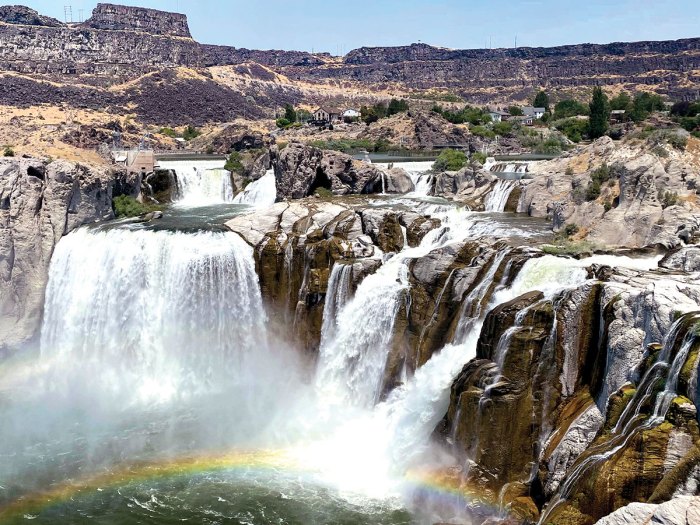
The troop stopped for lunch by Shoshone Falls in Twin Falls, Idaho, on its way to Bradley Scout Reservation. The falls are nicknamed the “Niagara of the West.”
Safety Gear
It’s important that on any float trip you wear the proper safety gear. Wear a whitewater-rated helmet and a life jacket that fit correctly.
To determine if your life jacket fits, put it on and secure the straps. Then lift your arms over your head. If it rides up around your ears, it’s too big. If you can’t secure the straps, it’s too small.
Leave a Comment